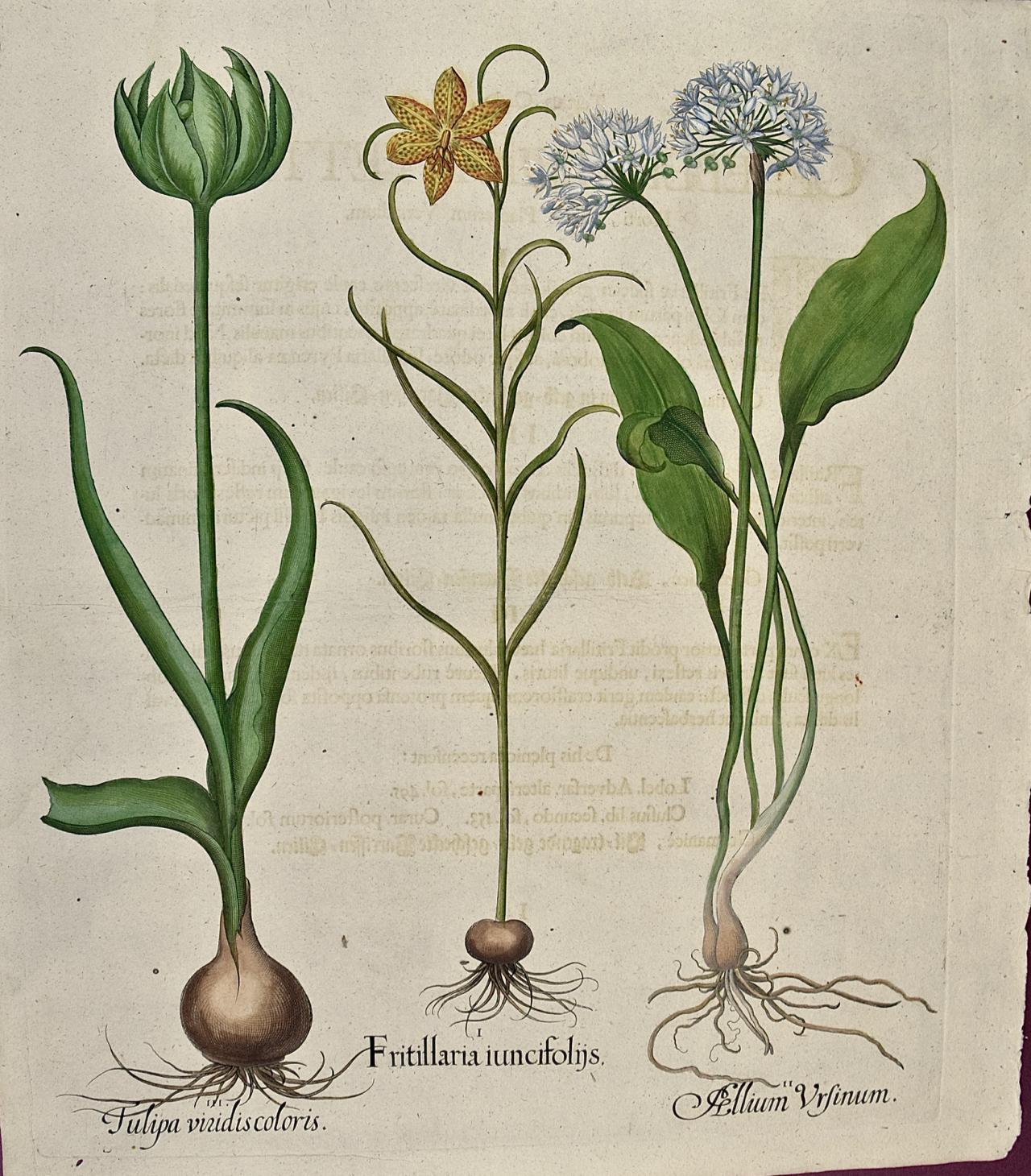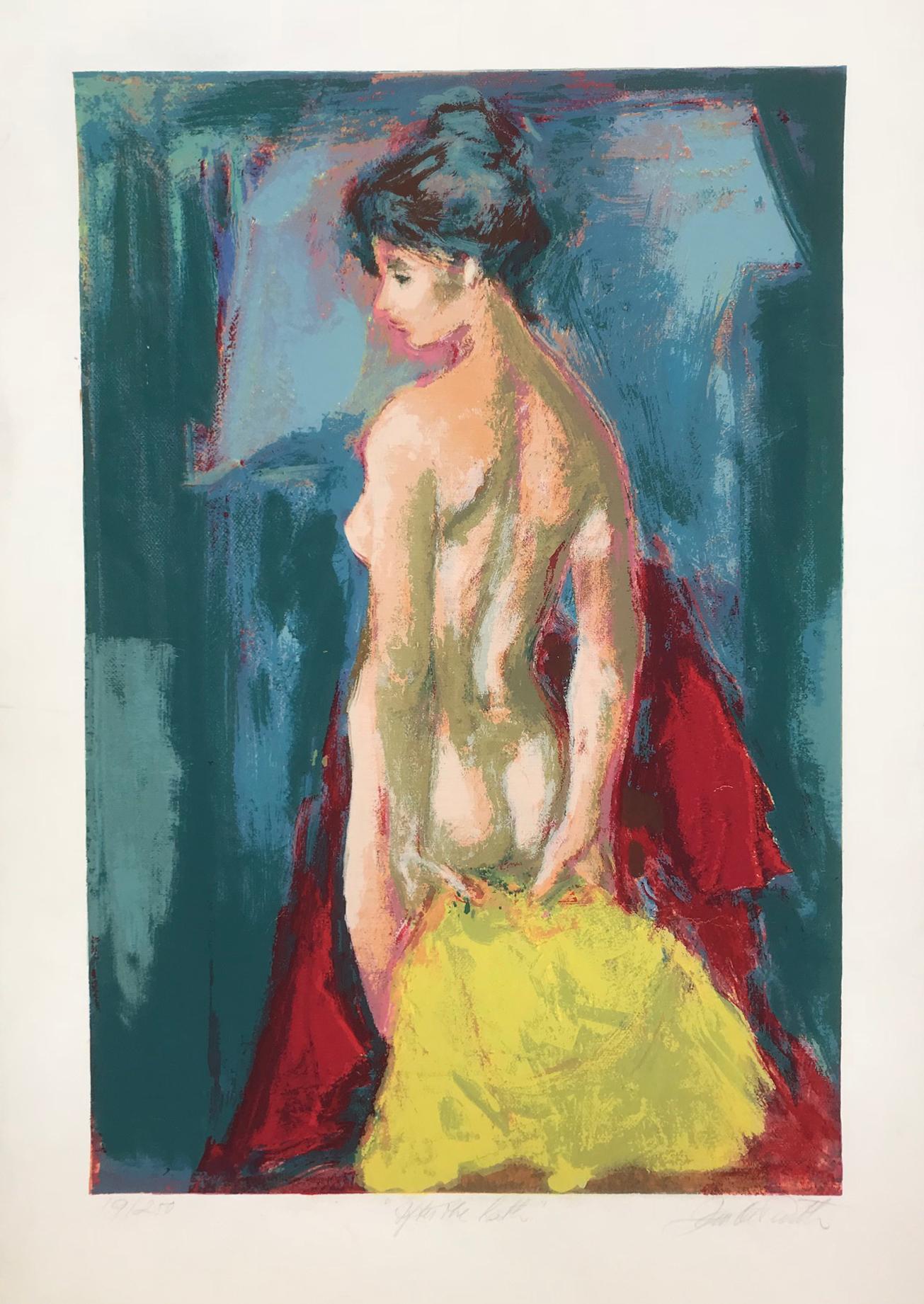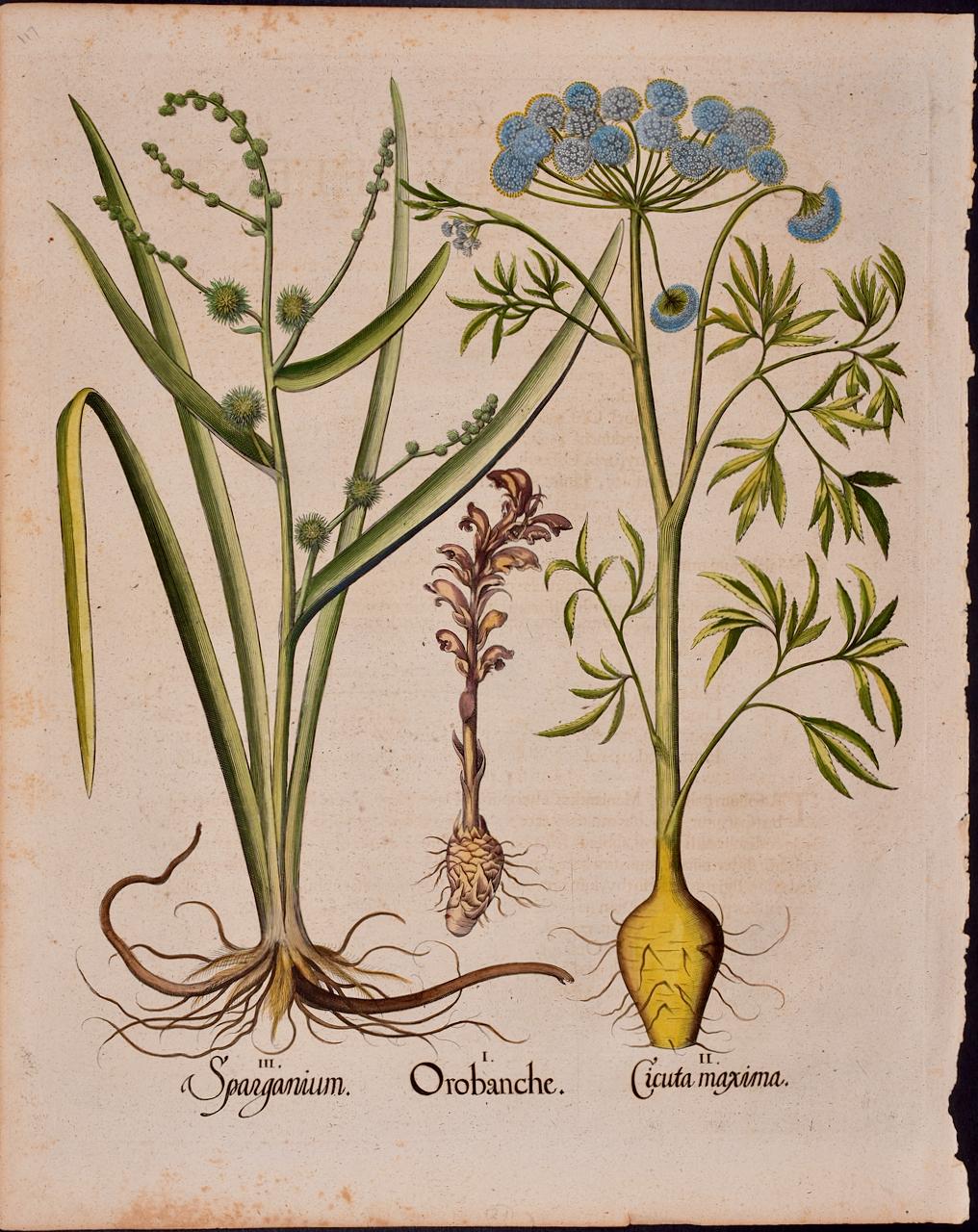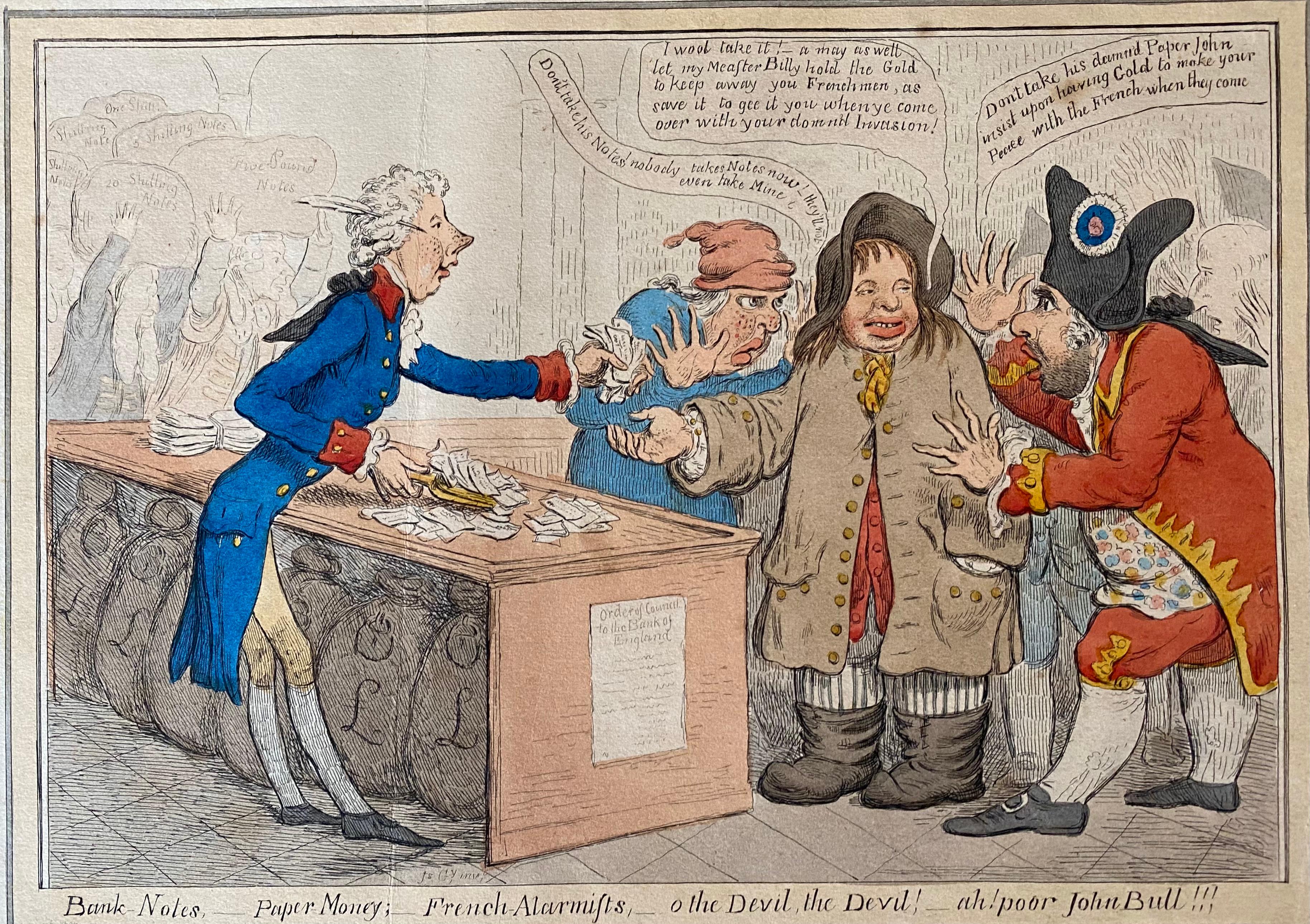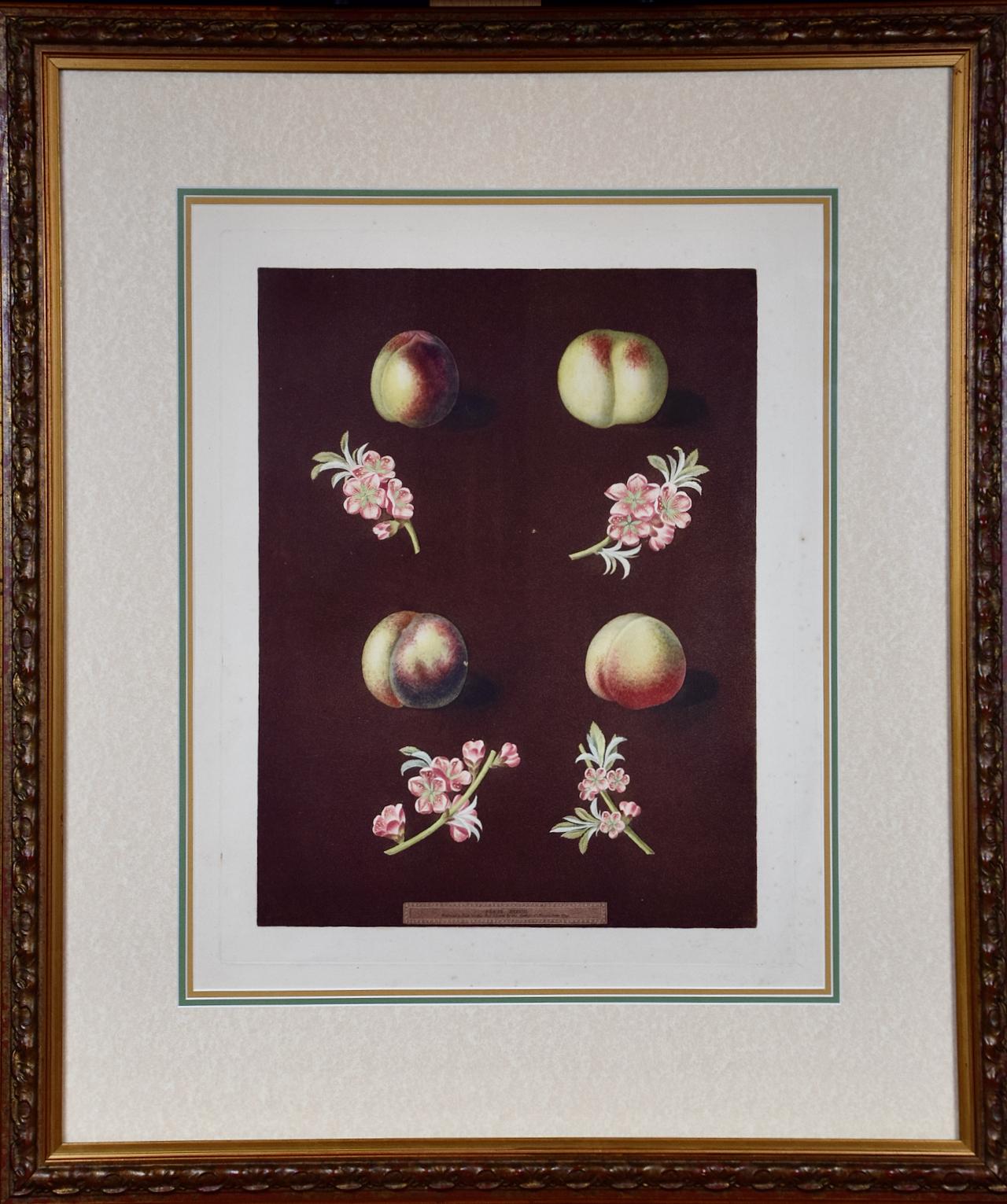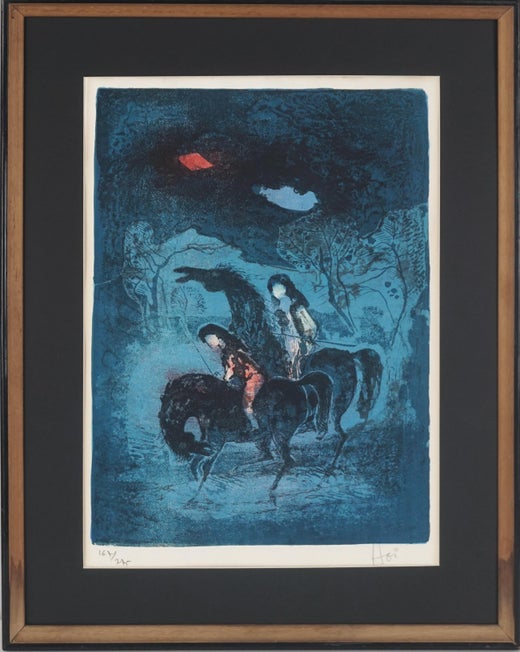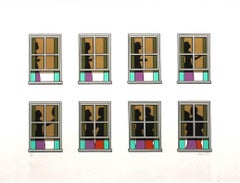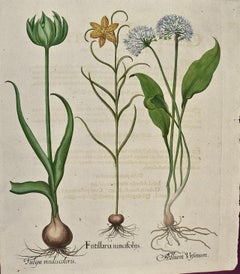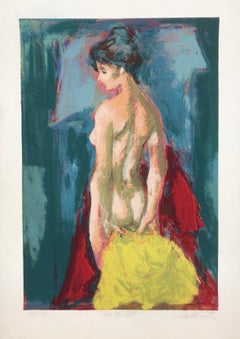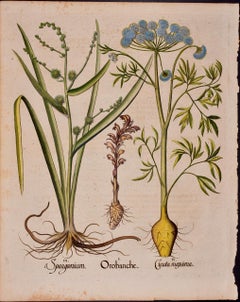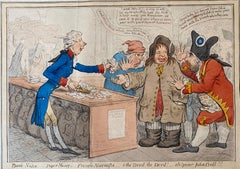Items Similar to Man and Sun Gold, Signed Abstract Screenprint by Lebadang
Want more images or videos?
Request additional images or videos from the seller
1 of 7
Hoi LebadangMan and Sun Gold, Signed Abstract Screenprint by Lebadangcirca 1975
circa 1975
About the Item
Artist: Lebadang, Vietnamese (1922 - 2015)
Title: Untitled - Man and Sun
Medium: Screenprint, signed in pencil
Edition: EA
Size: 30 x 22 in. (76.2 x 55.88 cm)
- Creator:Hoi Lebadang (1922 - 2015, Vietnamese)
- Creation Year:circa 1975
- Dimensions:Height: 30 in (76.2 cm)Width: 22 in (55.88 cm)
- Medium:
- Movement & Style:
- Period:
- Framing:Framing Options Available
- Condition:
- Gallery Location:Long Island City, NY
- Reference Number:Seller: RO547521stDibs: LU4668784362
Hoi Lebadang
Lebadang was born in 1921 in Bich-La-Dong, a village along the Huong River in Quang-Tri Province of Hue, Vietnam. He expressed himself through a variety of media, including painting, watercolor, sculpture, jewelry and graphic works. He often combined various media, creating sculptural, highly textured artwork. “Life is a sinking ship and work is a lifeboat.” This described her husband perfectly.
He lived in Paris since 1939, studying at the École des Beaux-Arts in Toulouse for six years until his first one-man show in 1950. He created large-scale abstract oil paintings with vivid blues and glowing puddles of orange and red. Painting and printmaking were Lebadang’s most frequently used media but he also worked in terra cotta and a variety of other media, such as “Vessel” (1994). Whatever he created, each piece spoke to the entangled roles of man and nature. In his 1981 “La Comédie Humaine,” he wrote: “In my work, I use the circle, the magic symbol of life, to enclose reliefs and landscapes. It symbolizes that nature is inseparable from man. Man finds sustenance and spiritual nourishment in every source.” And while the human form was not represented figuratively in his work until the late 1970s, he confirmed that man was always present.. His oil paintings of the ’60s are ambiguous at first glance, yet the faint outlines of boats, bridges, and horses gently float to the top. After his shift in style, bringing definition to his paintings, these dreams were made more lucid. Many of his figures become emotive and highly dramatic, this time with visible faces. . Mixing media, he painted aerial scenes of mountains and oceans where the viewer was stationed in the heavens. These paintings elaborated on man’s relationship to the natural world, continuously presented as a flurry of memories. Memories—objects that haunt the entire oeuvre of the artist—are a familiar subject to Lebadang. “Art, in all its forms, whether literature, philosophy, or the visual arts, expresses an attempt to understand the riddle of life and helps lessen the fear of death,” he wrote. His work is exhibited in many public and private collections, including the Cincinnati Museum of Art in Ohio, the Phoenix Art Museum in Arizona, the Rockefeller Collection in New York, the Foundation Museum in Kenya, the Lund University Museum in Sweden, the Loo Collection in Tokyo, and the Museum of Arts and Letters in France. Lebadang was honored with numerous awards and accolades during his career. He also designed an award for the International Institute of St. Louis. The Lebadang Award is presented biannually to an individual who has demonstrated extraordinary volunteer service. The award program was established by the institute in 1989 to recognize organizations and individuals who exemplify “Peace within you, your country, and the world.” “My artwork is often strange but simple,” Lebadang once said. “So everyone can hopefully feel happy and relaxed, and that’s why they like them.”
About the Seller
4.9
Platinum Seller
Premium sellers with a 4.7+ rating and 24-hour response times
Established in 1979
1stDibs seller since 2014
2,981 sales on 1stDibs
Typical response time: 1 hour
- ShippingRetrieving quote...Shipping from: Long Island City, NY
- Return Policy
Authenticity Guarantee
In the unlikely event there’s an issue with an item’s authenticity, contact us within 1 year for a full refund. DetailsMoney-Back Guarantee
If your item is not as described, is damaged in transit, or does not arrive, contact us within 7 days for a full refund. Details24-Hour Cancellation
You have a 24-hour grace period in which to reconsider your purchase, with no questions asked.Vetted Professional Sellers
Our world-class sellers must adhere to strict standards for service and quality, maintaining the integrity of our listings.Price-Match Guarantee
If you find that a seller listed the same item for a lower price elsewhere, we’ll match it.Trusted Global Delivery
Our best-in-class carrier network provides specialized shipping options worldwide, including custom delivery.More From This Seller
View AllCarrying Fruit Gold Leaf Screenprint by Lebadang
By Hoi Lebadang
Located in Long Island City, NY
Artist: Lebadang, Vietnamese (1922 - 2015)
Title: Untitled - Carrying Fruit
Medium: Silkscreen, signed in pencil
Edition: EA
Size: 47 x 20.5 in. (119.38 x 52.07 cm)
Category
1970s Academic Figurative Prints
Materials
Gold Leaf
Urban Walls, Pop Art Screenprint by Tom Smith
By Tom Smith
Located in Long Island City, NY
Artist: Tom Smith, American (1937 - )
Title: Urban Walls
Year: 1973
Medium: Screenprint, Signed and numbered in pencil
Edition: 75/150
Image Size: 16.5 x 25 inches
Category
1970s Contemporary Figurative Prints
Materials
Screen
Paris Bourse, Pop Art Screenprint by LeRoy Neiman
By LeRoy Neiman
Located in Long Island City, NY
Artist: LeRoy Neiman (American, 1921-2012)
Title: Paris Bourse
Year: 1981
Medium: Screenprint, signed and numbered in pencil
Edition: PP
Image Size: 29.5 x 37 inches
Frame Size: 41 ...
Category
1980s American Modern Figurative Prints
Materials
Screen
Freedom From Fear, Pop Art Screenprint by Daniel Joseph Martínez
By Daniel Joseph Martinez
Located in Long Island City, NY
Daniel Joseph Martinez, American (1957 - ) - Freedom From Fear, Year: 1990, Medium: Screenprint, signed and numbered in pencil, Edition: 8/60, Image Size: 34.5 x 49.5 inches, Siz...
Category
1990s Pop Art Figurative Prints
Materials
Screen
Skier II, Signed Screenprint by Wayland Moore
By Wayland Moore
Located in Long Island City, NY
Skier II
Wayland Moore, American (1935)
Date: circa 1980
Screenprint, signed and numbered in pencil
Edition of 182/300
Image Size: 18 x 24 inches
Size: 23 x 29 in. (58.42 x 73.66 cm)
Category
1980s Figurative Prints
Materials
Screen
Prevalence of Ritual, Portfolio of Screenprints by Romare Bearden
By Romare Bearden
Located in Long Island City, NY
The complete portfolio of Romare Bearden's "Prevalence of Ritual" suite. In 1969, the Art Workers Coalition (AWC) submitted a list of demands to MoMA in New York. Included in this li...
Category
1970s Figurative Prints
Materials
Screen
You May Also Like
Besler Hand-colored Botanical Engraving of Flowering Tulip & Wild Garlic Plants
Located in Alamo, CA
This is a hand-colored copperplate engraving entitled "Tulipa viridiscoloris, Fritillaria iuncifolns, Allium Vrsinum" depicting flowering tulip, fritillary and wild garlic plants fro...
Category
Early 18th Century Academic Still-life Prints
Materials
Engraving
After the Bath (Edition 19/250)
By Jan De Ruth
Located in New York, NY
Jan De Ruth (American/ Czech, 1922-1991), " After the Bath" Edition 19/250, Figurative Lithograph on Paper signed and titled in Pencil, 30 x 21 (Image: 25 x 15.50), ca. 1970s, Late 20th Century
Colors: Blue, Yellow, Red, Grey, White, Purple
Jan De Ruth enjoyed special popularity as a portrait artist and has become one of the best known painters of the nude female in the world today.
It's a long way from sketching in leftover coffee to painting a portrait of Ethel Kennedy for the cover of Time Magazine, twenty-five years in fact; and during that period, Jan De Ruth's personal experiences have been enough to fill two ordinary lifetimes. Through them all, art has sustained him and been his primary interest.
To begin with, De Ruth, a native of Czechoslovakia and now an American citizen, spent the years of World War II being shunted through 5 different concentration camps, including the infamous Auschwitz. He made four escape attempts and finally made good on his fifth try.
De Ruth constantly sought materials with which to draw, but "The only things we had were the few pieces of cloth we wore," he recalls. By chance, he was transferred to Germany as part of a labor detail and managed to sneak a pencil away from the camp supervisor-"I became a perfect thief during those years," he says. Jan drew a mother and child on a scrap of paper he scrounged from the factory where he worked, filled it in with shadings of coffee in various strengths-his finger was his brush. He exchanged the sketch for a piece of bread from a camp guard, and in effect, sold his first painting.
In March of 1945, after being transferred to his native Czechoslovakia, he made his successful escape "knowing every step of the way." After the war, De Ruth became the commissar in a small Czech town and remained in the post for one year, just long enough to forge some documents that allowed him to flee to England. He took up residence in London and enrolled at the Ruskin Art School in Oxford University. He arrived in the USA in 1948.
There are times in the life of a painter when his dedication to his art is overshadowed by the immediate requirements of self-preservation. This was one of those times! From '48 to 1955 he supported himself by working at night, earning his way painting designs on neckties and bathroom cups; as a fashion designer, illustrator, vacuum cleaner salesman, theatre manager, and actor. In '55 Jan De Ruth made his professional debut as a full-time artist and two years later his first one-man show established him as a serious painter.
His work has been acclaimed for combining the technique of the old masters with a modern manner, and has been exhibited in more than 40 one-man shows in galleries and museums across the United States. He has been judged positively by juries in 28 national exhibitions and his numerous awards include the Purchase Prize of the Butler Institute of American Art, and the Gold Medal of the National Arts Club.
De Ruth, author of the books "Portrait Painting" and "Painting the Nude," has devoted his entire life to painting the female face and form. He enjoys special popularity as a portraitist and has become one of the best known painters of the nude female in the world today. Often asked why he concentrates on this most demanding of all art subjects he replies: . . . "Each painting of the nude becomes a new experience . . . It (the human figure) is nature's most perfect and most imperfect creation, communicating, even in silence and immobility, the physical and spiritual power-and frailty-of humanity."
Articulate, sophisticated, outspoken and well informed, De Ruth has also been a welcome guest on radio and television shows. But, it is painting that gives a purpose to Jan De Ruth's existence: "It is an unending challenge-there is no end, no final result-to be found in painting the human body. I have never seen two gestures that are alike, but so are the possibilities of expression. There will always be painters who will find one more way of saying: "See! This is what I feel about humans." . . . So until a greater challenge and a more profound symbol comes along, it is the human figure I wish to paint."
AWARDS
Butler Institute of American Art Purchase Prize
Oguniquit Art Center
Knickerbocker Artist 1964
Audubon Artist, Grumbacher Purchase Prize
National Arts Club of America Gold Medal
Windsor-Newton Award of the National Arts Club
ONE MAN MUSEUM EXHIBITIONS
B'nai B'rith Museum - Washington D.C.
Florida Gulf Coast Art...
Category
1970s Academic Abstract Prints
Materials
Lithograph
Bur Reed & Water Hemlock: A 17th-18th C. Besler Hand-colored Botanical Engraving
Located in Alamo, CA
This is a hand-colored copper plate engraving entitled "Orobanche, Cicuta Maxima, Sparganium (Bur Reed, Water Hemlock, Broomrape) ", depicting a flowering Bur Reed, Water Hemlock, Broomrape plants from Basilius Besler's landmark work, Hortus Eystettensis (Garden at Eichstatt), first published in 1613 in Eichstatt, Germany near Nuremberg and later in 1640 and 1713.
This beautiful colorful engraving is printed on thin laid chain-linked paper with wide margins. There us spotting and some discoloration, most prominently in the upper and lower margins. There is irregularity and some loss along the right paper edge. The print is otherwise in excellent condition with striking hand-coloring. The sheet measures 21.5" high and 17.25" wide.
Basilius Besler (1561–1629) was an apothecary and botanist. He was curator of the Willibaldsburg Castle garden of Johann Konrad von Gemmingen, prince bishop...
Category
Early 18th Century Academic Still-life Prints
Materials
Engraving
“Bank Notes”
By James Gillray
Located in Southampton, NY
James Gillray (13 August 1756 – 1 June 1815) was a British caricaturist and printmaker famous for his etched political and social satires, mainly published between 1792 and 1810. Many of his works are held at the National Portrait Gallery in London.
Description:
Pitt (left) as a bank-clerk, very thin and much caricatured, a pen thrust through his wig, stands behind an L-shaped counter offering a handful of bank-notes to John Bull. In his right hand is a scoop with which he sweeps up notes from the counter. John is a yokel no longer bewildered. He stands stolidly, holding out his left hand for the notes, his right hand in his coat pocket. Fox (right) wears a high cocked hat...
Category
1790s Academic Figurative Prints
Materials
Etching, Archival Paper
$1,200 Sale Price
27% Off
Peaches, Nectarines: George Brookshaw's 19th C. Framed Hand-colored Aquatint
By George Brookshaw
Located in Alamo, CA
George Brookshaw's (1751-1823) beautiful "Peaches, Nectarines" hand colored aquatint engraving, plate 38 from his "Pomona Brittanica", considered to be the finest British botanical large format treatise of the 19th-century. His engravings were unique for their rich tones and colors, elegant compositions with the fruit seeming to float on a mottled sumptuous background. The pale green and peach-colored peaches and the pink and green flowers lie on a rich dark brown-colored background.
The print is presented in an ornate bronze-colored wood frame with gold-colored inner and outer trims and a triple mat. The outer mat is a marbled light...
Category
Early 19th Century Academic Figurative Prints
Materials
Aquatint
Giorgio De Chirico ( 1888 – 1978 ) – Autoritratto – hand-signed lithograph –1970
By Giorgio De Chirico
Located in Varese, IT
Original color lithograph , edited in 1970
limited edition
signed in pencil in lower right corner and numbered as: 72/110
paper size: 70 x 53,5 cm
framed size: 93,5 x 77 cm ( origina...
Category
1970s Academic Prints and Multiples
Materials
Paper, Lithograph
Recently Viewed
View AllRead More
Romare Bearden’s Humanity Infuses His Bright, Bold Art
Through collage, painting and printmaking, the artist foregrounded Black life in America in revolutionary new ways.
Chryssa’s 1962 Neon Sculpture Was Way ahead of the Art-World Curve
By working with lettering, neon and Pop imagery, Chryssa pioneered several postmodern themes at a time when most male artists detested commercial mediums.
